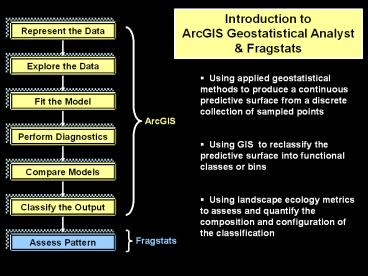Introduction to ArcGIS Geostatistical Analyst - PowerPoint PPT Presentation
Title:
Introduction to ArcGIS Geostatistical Analyst
Description:
Introduction to ArcGIS Geostatistical Analyst & Fragstats Represent the Data Explore the Data Using applied geostatistical methods to produce a ... – PowerPoint PPT presentation
Number of Views:1051
Avg rating:3.0/5.0
Title: Introduction to ArcGIS Geostatistical Analyst
1
Introduction to ArcGIS
Geostatistical Analyst Fragstats
Represent the Data
Explore the Data
- Using applied geostatistical methods to produce
a continuous predictive surface from a discrete
collection of sampled points - Using GIS to reclassify the predictive surface
into functional classes or bins - Using landscape ecology metrics to assess and
quantify the composition and configuration of the
classification
Fit the Model
ArcGIS
Perform Diagnostics
Compare Models
Classify the Output
Assess Pattern
Fragstats
2
Representing the Data
Converting data to GIS format
The first step requires that the data be
converted into a format that can be used by the
GIS software
3
The interpolation techniques used by the
software work best with normally distributed
data.
Exploring the Data
Are there outliers?
Are there global trends in the data?
How are the data distributed?
4
THE SEMIVARIOGRAM
The semivariogram models the spatial dependence
or autocorrelation between measured points. The
semivariogram cloud shows ½ the squared
difference between all pairs of points as a
function of separation distance (h).
Modeling the semivariogram is the key step
between spatial description and spatial
prediction. Choosing the best model or
continuous function to fit the empirical
semivariogram helps ensure that the predicted
values are as accurate as possible.
5
When fitting a model to the semivariogram it is
important to consider
Directional Trends
Anisotropy Things are more alike for longer
distances in some directions than in other
directions
6
Fit the Model
Perform Diagnostics
The ArcGIS Geostatistical Wizard uses a series of
steps to calculate a best fit model create a
predictive surface
2
3
1
Model the semivariogram
Account for global trends
Choose the method
4
5
Set search neighborhood
Assess the diagnostic stats
7
Compare Models
Which model is best?
8
Classify the Output
Reclassify predictive surface raster into
categories or functional groups
9
Assess Pattern
Using metrics of landscape ecology, assess
pattern of classified data using Fragstats
Input classified input grid
Output spreadsheet of selected metrics































